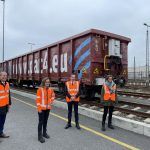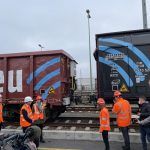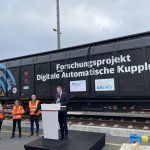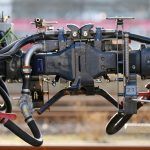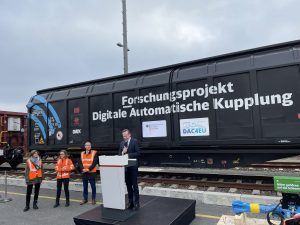 Germany’s Federal Minister for Digital and Transport, Volker Wissing, the DB Management Board Members Daniela Gerd tom Markotten and Sigrid Nikutta and the head of the Representation of the European Commission in Germany, Jörg Wojahn, inaugurated the test journey of the DAC4EU demonstrator freight train expected to be completed by the end of this year.
Germany’s Federal Minister for Digital and Transport, Volker Wissing, the DB Management Board Members Daniela Gerd tom Markotten and Sigrid Nikutta and the head of the Representation of the European Commission in Germany, Jörg Wojahn, inaugurated the test journey of the DAC4EU demonstrator freight train expected to be completed by the end of this year.
As the freight wagons in rail traffic are currently coupled manually, the digital automatic coupling (DAC) is an essential component of digitalising and automating rail freight traffic and allows for universal power and data lines across all freight wagons. The digital solution makes rail transport more competitive than road, significantly increases infrastructure capacities and contribute to the European climate targets.
The railcar connections for the brakes are also made automatically and for the first time, freight wagons will be equipped with end-to-end power and data lines.
The DAC makes faster, automated shunting processes possible. Overall, the capacity of transshipment stations increases significantly and freight trains can become longer and heavier with the new coupling technology. The solution is also important as allows trains to run at higher speeds increasing the capacity of the rail network.
“Reconciling the growing volume of transport with our climate protection goals is one of the greatest challenges of our time. Rail is the key to this – even if we have some catching up to do in freight transport. True to our motto ‘Dare for more progress’, we will solve a problem that has existed for more than 70 years with the EU-wide introduction of a uniform automatic coupling system and catapult more than half a million freight wagons into the 21st century,” Volker Wissing said.
In the past few months, trip and coupling tests were conducted on German lines and at the marshalling yards. The freight train of the future will first travel from Germany to Austria and then to Switzerland and other EU countries will then follow. The DAC is being tested in different driving situations than would be possible in Germany. These include steep inclines, tighter curves or other climatic conditions. The demonstration and the operational tests should lead the DAC series production and the goal is a EU-wide introduction of the solution paving the way for the comprehensive automation and digitalisation of rail freight traffic in Europe.
The research project started in June 2020 and will be completed in December 2022 after the practical tests.
The DAC4EU demonstrator freight train is part of a research project with a EUR 13 million funding from the Federal Ministry of Transport and Digital Infrastructure that awarded six companies from Austria, France, Germany and Switzerland been awarded a contract to conduct the DAC Demonstrator for Rail Freight Traffic project. DB, DB Cargo, the Swiss and Austrian freight operators SBB Cargo and Rail Cargo Austria, and the wagon keepers Ermewa, GATX Rail Europe and VTG are the members of the DAC4EU (gital Automatic Coupling for Europe) consortium.
As the European Commission has highlighted the essential role of modal shift to sustainable transport modes – railways and waterways – and intends to increase the rail freight volumes by transferring the goods from road transport, the digital automatic coupling project marks the milestone “on the way to climate neutrality, the goal that we as Europeans have set for ourselves by 2050. More goods have to be shifted to rail – not just in Germany, but throughout the European internal market. Only together can we achieve the European goal of doubling the share of freight transport by rail by 2050. The EU has created the structures for cooperation: Shift2Rail under the umbrella of which this project was and is being promoted throughout Europe,” the representative of the EC in Germany said at the ceremony.
Share on:



